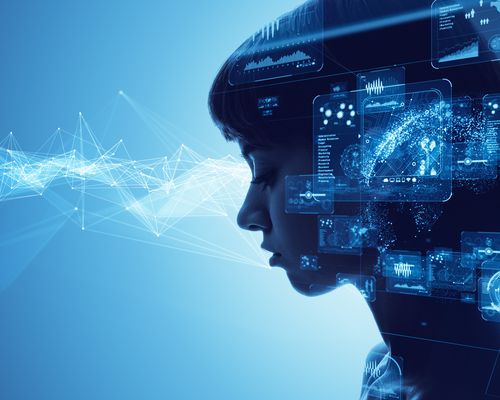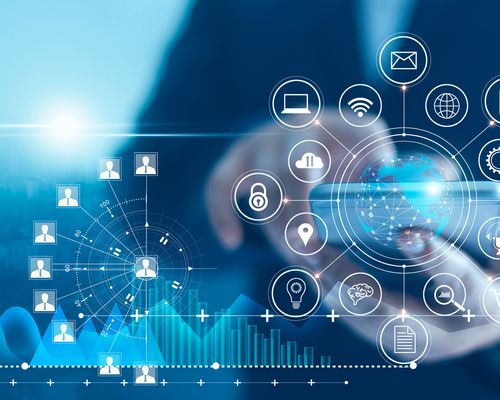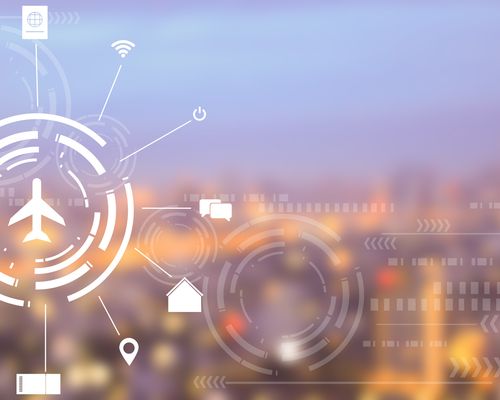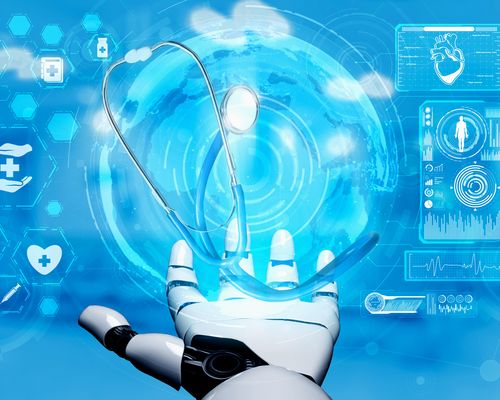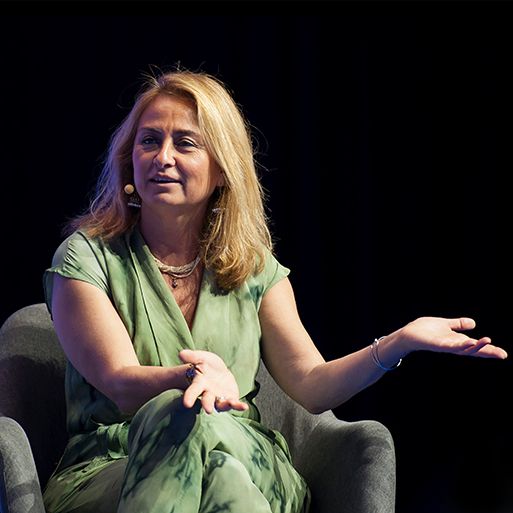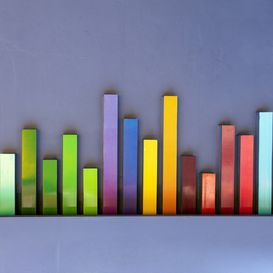

3. Calls overview

3.1. ITEA programme size
(Status 31 December 2022)
At the moment, three Calls from ITEA 3, one Call from ITEA 4 and the three Joint Eureka Clusters Calls: AI Call 2020, AI Call 2021 and Sustainability Call 2022 (where the projects received their label on 18 November 2022) are all running. Furthermore, projects for ITEA Call 2022, the second Call of ITEA 4, have recently submitted their Project Outlines. In total, 32 projects submitted a Project Outline (PO) and, after evaluation, 24 projects were invited to submit their Full Project Proposals (FPP). The submission deadline for the FPPs is 13 February 2023.
In total, 55 projects of the ITEA 3 Programme have been completed, of which 14 projects ended in the past year. Currently, 42 projects are running (27 projects from ITEA 3, three projects from ITEA 4 and 12 projects from the Joint Eureka Clusters Calls). 20 projects are still waiting for their final funding decisions (13 projects from ITEA 3 and 4 and seven projects from the Joint Eureka Clusters’ Calls AI Call 2021 and Sustainability Call 2022 with ITEA as the main Cluster).
All projects from ITEA 3 Calls 1 to 4 have now been completed with funded Call sizes of €103 M, €119 M, €104 M and €120 M respectively. Call 5 developed toward €93 M and, due to a lack of funding and delays in funding decisions in Call 6, only nine out of 20 projects started and the funded Call size realised will only be around €60 M. Although there are still quite a few pending decisions, Call 7 signals a slight increase in the funded Call size, which is forecasted between €65 M and €70 M. On the other hand, the funded Call size for the Joint Eureka Clusters AI Call 2020, which is running in parallel to ITEA Call 6, will reach a size of around €32 M. With some projects still facing pending funding decisions, Joint AI Call 2021, running in parallel to ITEA Call 7, is forecasted to reach a Call size of around €25-28 M. Finally, the projects from the Joint Eureka Clusters Sustainability Call 2022 only received their label on 18 November. While there are no funding decisions yet, the funded Call size for the projects of this Call with ITEA as the main Cluster is forecasted to be between €6 M and €10 M.
Funded Call size for ITEA Calls and Eureka Clusters Calls in € M
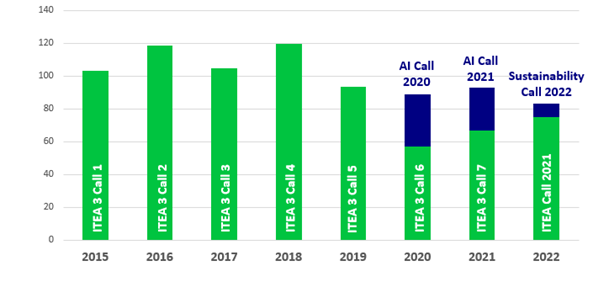
3.2. ITEA Calls progress
3.2.1 ITEA Calls and Joint Eureka Clusters Calls progress
In the following graph, the progress of the ITEA Calls is represented by several hit rates. These hit rates show the percentage of the projects, efforts and costs actually accomplished or actually running in the ITEA programme compared to the projects, efforts and costs initially labelled.
ITEA hit rate for ITEA Calls and Joint Eureka Clusters Calls
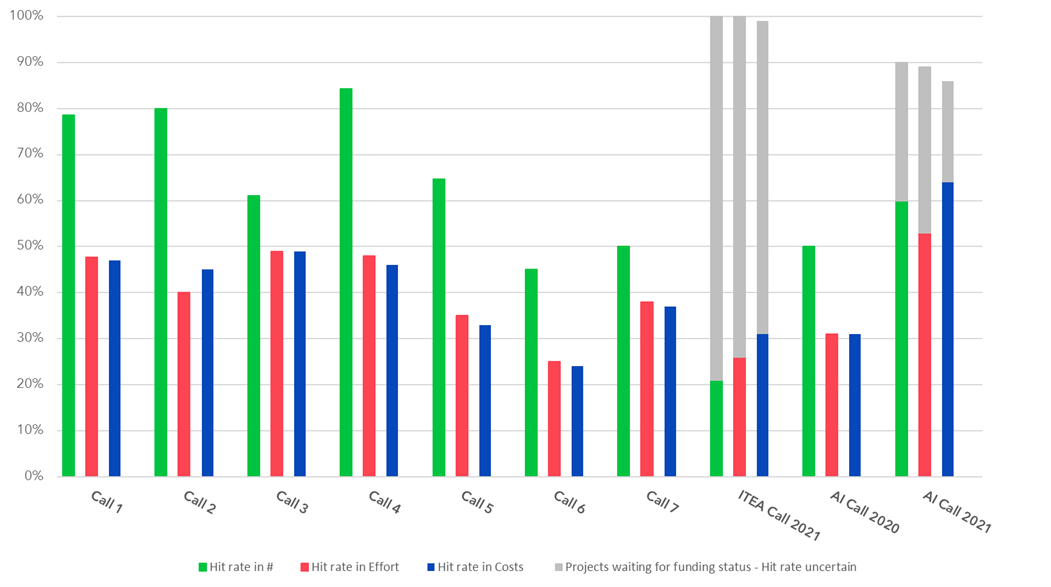
All projects in ITEA 3 Call 1, Call 2, Call 3 and Call 4 have now been completed. ITEA 3 Call 5, Call 6 and Call 7 are still subject to some (minor) changes as Change Requests are also possible for ongoing projects. Nevertheless, these Calls are rather stable now. The same goes for the Eureka Clusters AI Call 2020, which reached a hit rate of 50% in terms of number of projects; the same as the hit rate for ITEA 3 Call 7, although that Call shows a higher hit rate in terms of costs and effort.
After very low hit rates for Call 6, there has been an improvement for ITEA 3 Call 7 and this improvement can also be expected for ITEA Call 2021 and AI Call 2021. However, for ITEA Call 2021 and AI Call 2021, there are still a lot of uncertainties, making it hard to give a good estimate of the final hit rates for these Calls.
As the Eureka Clusters Sustainability Call projects were only recently labelled, this Call has not been taken into account in these hit rate figures.
A quick start to a project can have a positive impact on maintaining its original size as partners remain involved and the topic remains relevant, as is also visible in Figure 2. The time from project idea to project start has therefore been a high-level KPI in ITEA for a few years now. As the result of the fact that this KPI did not improve over the first ITEA 3 Calls, the ITEA label validity deadline was implemented as of ITEA 3 Call 3.
Months between idea and project start of ITEA projects
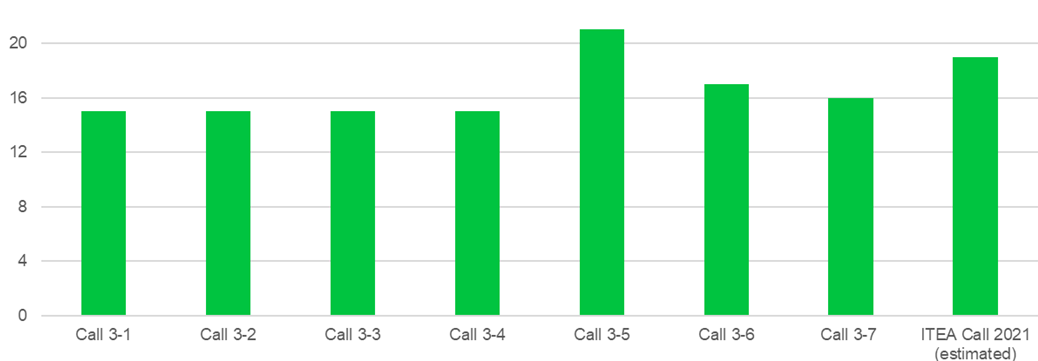
Due to several circumstances and the changing environment, however, the label validity deadline has not yet resulted in a reduction of the time-to-project. Regarding ITEA 3 Call 5, the time-to-project for this Call was even more than the previous Calls due to funding decisions in Germany and the changed situation in France. Call 6 was a special case as it never reached the hit rate threshold of 50% of projects started as only nine out of 20 projects started. For Call 7, a shorter time from idea to project was reached with 16 months, which is an improvement compared to Call 5 and Call 6. Nevertheless, it is expected that ITEA Call 2021 will hit the threshold of 50% in 19 months, which is again longer than ITEA 3 Call 7, and this is still not close to the desired level of 12 months or less, so this remains one of our improvement priorities.
The current status of the ITEA projects is as follows:
| 2022 | 2021 | |||||
|---|---|---|---|---|---|---|
| # | Effort in PY | Cost in €M | # | Effort in PY | Cost in €M | |
| Labelled during the year | 18 | 2417 | 194 | 26 | 3007 | 279 |
| Running at end of the year | 43 | 3752 | 351 | 41 | 3722 | 352 |
| Waiting at end of the year | 17 | 1877 | 135 | 20 | 1928 | 164 |
| Completed during the year | 14 | 1361 | 119 | 8 | 631 | 65 |
| Cancelled during the year | 5 | 512 | 48 | 17 | 2216 | 207 |
3.3. ITEA project landscape
To create innovation-driven growth, ITEA needs to focus on future markets and the challenges posed by a fast-changing world in which ‘smart’ is the key concept. At present, there are eight main societal challenges that the ITEA Community addresses. The figure below shows the distribution per Call of the ITEA projects across these challenges, except for the Smart energy challenge that was introduced only in 2021. Over time, the strongest contribution has been in the field of Smart engineering, with a very good coverage of the Smart health, Safety and Security and Smart industry challenges as well. As Joint Eureka Clusters Calls do not use the same main societal challenges, figures from these Calls are not represented in this graph.
Challenges of ITEA 3 Calls 1-7 and ITEA Call 2021
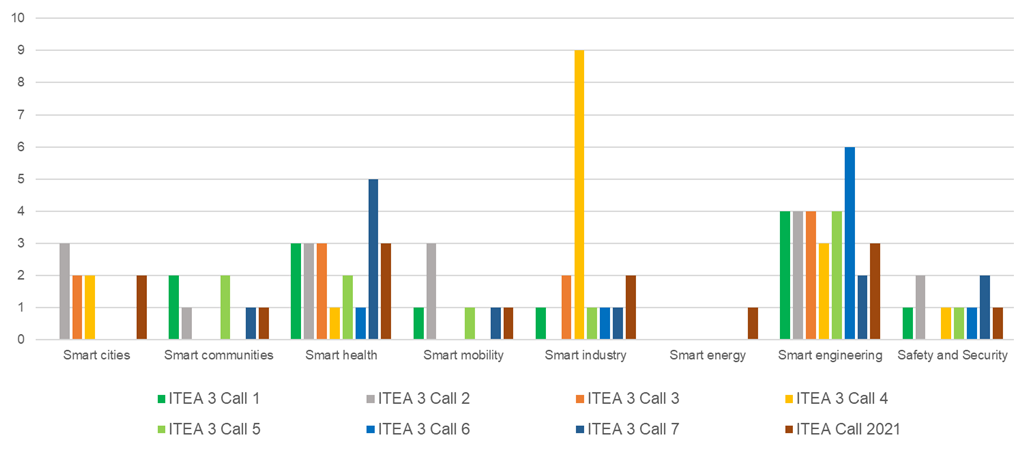
3.4. New projects - ITEA Call 2021
The first Call of ITEA 4, ITEA Call 2021, delivered 15 submitted FPPs, ultimately resulting in 14 labelled ITEA projects involving 2205 PY and 14 countries. This Call has generated projects for all of the eight ITEA smart challenges, showing the relevance of the bottom-up approach. We again have a strong participation of SMEs, which represent almost half of the total effort of the labelled projects. The SMEs are complemented by many large industrial players (around 30% of the total effort) and high-level academic partners (around 20% of the effort). It is interesting to note that we have a healthy rate of newcomers as more than 50% of the project partners have not been involved in ITEA projects during the past five years.
As mentioned above, it is expected that the size of several ITEA Call 2021 projects will be reduced due to some (delays in the) funding decisions. In February 2023, LimitLess was cancelled. Due to lack of funding in the main countries, some additional projects might be cancelled in the coming months.
The themes arising from this Call are:
| Theme | ITEA Call 2021 projects |
|---|---|
| Smart engineering | GenerIoT, ZEE |
| Smart health | DAIsy, RM4HEALTH, SYMPHONY |
| Safety and Security | VESTA |
| Smart communities | EARS |
| Smart mobility | TAPCOP |
| Smart industry | EXPAI SmartIndustry, TiDiT |
| Smart energy | BENTRADE |
| Smart cities | AIMOB SmartCity, SOCFAI |
A short description of each project can be found below:



DAIsy
Developing AI ecosystems improving diagnosis and care of mental diseases
Project leader
ARD GROUP
(Türkiye)
Major depressive disorder (MDD) is a common psychiatric disorder, ranking as the second leading contributor of years lived with disability. Finding the right approach for individual patients remains challenging. DAIsy will develop and bring to the market AI-supported solutions for improved diagnosis, treatment selection, diet monitoring, activity tracking, support in behaviour adjustments, and treatment response assessment. Novel AI techniques will be jointly developed to advance the AI applicability for these fragile patients by advancing techniques for large data points/patient ratios, improving explainability and uncertainty quantification.




EARS
Environment Adaptive Recommendation System
Project leader
ARD GROUP
(Türkiye)
The main problem of many domains is a lack of information and guidance, as potential customers cannot be reached because there is not enough information and guidance towards the right products. The EARS project aims to bring together all parties in the value chain, creating an ecosystem, providing a new platform that fits the purposes of all parties and enabling them to collaborate. Entities such as businesses, algorithm developers, solution providers, service providers and recommendation systems are brought together to enhance their capabilities or those of others, monetising the artefacts by utilising them as a service.





EXPAI SmartIndustry
Integrating AI into smart control systems, and increasing productivity for industrial areas
Project leader
Nanosystems Co., Ltd.
(Republic of Korea)
Smart technologies are gaining higher importance while supporting Artificial Intelligence technologies that we use in our lives. The main goal of this project is to provide a flexible, controllable digital environment supported by an Explainable Artificial Intelligence digital smart platform that will collect and analyse sensor data from various resources for different domains. These will be combined in a common framework in industrial areas and the retail market. The project will present novel methods and solutions for the industrial market and real-life use-cases for exploitable solutions.




GenerIoT
Generating and Deploying Lightweight, Secure and Zero-overhead Software for Multipurpose IoT Devices
Project leader
Infineon Technologies AG
(Germany)
Distributed hardware/software systems (often interconnected via the internet) which gather information via sensors and influence the environment via actors must be up to date, especially with regard to security. Additionally, connectivity offers the opportunity to adjust in-field systems to user needs. This requires an efficient development flow enabling short development cycles. GenerIoT will provide new technologies and processing steps in order to simplify and speed up the handling of IoT software over the complete DevOps cycle. The approach proposed by GenerIoT will open new business opportunities: IoT apps.




RM4HEALTH
Remote Monitoring in Health and sports
Project leader
Philips Electronics Nederland BV
(The Netherlands)
Wearable health monitoring systems provide a big promise of allowing individuals to closely monitor changes in their vital signs and provide feedback to regain or maintain an optimal health status. The RM4Health project will accelerate innovation in electronic wearable devices. RM4HEALTH will focus on the development of open technology platforms for vital sign monitoring for these emerging fields to help them bridge ‘the Valley of Death’ in a shorter time and at a lower cost. RM4HEALTH aims to stimulate innovation in continuous monitoring in healthcare and sports.



SOCFAI
Secure Open Collaboration Framework powered by Artificial Intelligence
Project leader
TAV Technologies
(Türkiye)
The SOCFAI project focuses on airports and addresses the problems caused by the collaborative and multi-stakeholder nature of their operations. This is providing new ways to manage the operations cycle, enable real-time common situational awareness of all aspects of airport operations, optimise different core processes, enable predictive and fully integrated operations management and facilitate customer service management and orientation, all while trying to improve overall customer satisfaction levels by introducing an open-source framework equipped with technologies such as AI, Computer Vision, VR, IoT, LIDAR, etc.





SYMPHONY
Eco-system for disease specific clinical workflow and data integration
Project leader
Philips Electronics Nederland BV
(The Netherlands)
Healthcare today faces many challenges like improving patient outcome, working cost-effectively while finding a balance with growing demand, declining staff capacity and new clinical/technological developments. COVID has clearly shown the urgency for healthcare IT to ensure efficient decision-making and co-operation and a reduction of strain on the sector. The most effective way to achieve this is to unlock the full potential of the knowledge hidden within the enormous amounts of medical data generated. The objective of SYMPHONY is to create an open healthcare IT ecosystem, providing care professionals with real-time, comprehensive insights into a patient’s status and integrating all relevant information for diagnosis, treatment selection and follow-up.


TAPCOP
Traffic AI Prediction of Common Operational Picture
Project leader
Macq
(Belgium)
Authorities continuously struggle with managing and controlling traffic and crowds to prevent safety incidents and discomfort. They lack efficient solutions to prevent these problems. TAPCOP realises situational awareness and data-driven management of visitor flows, provides AI-based sensors and aggregates multiple data sources using AI to create a more reliable and complete view of the situation and predict overcrowding. TAPCOP offers a one-stop solution for multi-modal mobility management and prevention of overcrowding by personally advising visitors pre-trip, on-trip and on-site via social media, navigation systems and other mobile phone apps.


TiDiT
Timeline-Driven Digital Twin
Project leader
BITES
(Türkiye)
The current digital twin services on the market do not completely fulfil customer needs and are unable to prevent unexpected breakdowns and provide cost-effective models. Moreover, end-users have to set up every simulation using different software, which results in high costs, time and effort. By bringing together different software capabilities while fulfilling customer needs with the implementation of innovative technologies, the TiDiT project aims to create an ‘as a service’ model timeline-driven digital twin platform to enable a better decision-making process and increase situational awareness.



VESTA
Proactive protection against phishing-based ransomware
Project leader
duSoft Yazılım A.Ş.
(Türkiye)
Every year, millions of users fall victim to malware threats in various ways. The VESTA project aims to develop a European cybersecurity system to proactively protect systems against ransomware attacks. It combines multiple techniques such as AI/ML, data & knowledge extraction, anti-phishing, human behaviour analysis and sandboxing to build a multilayer ransomware attack mitigation platform capable of preventing, defending and remediating such attacks. Moreover, VESTA may also tackle the challenges related to the multi-language nature of phishing emails via collaboration between partners from different countries.
3.5. New projects - Eureka Clusters Sustainability Call 2022
The Eureka Clusters Sustainability Call 2022 delivered 15 submitted FPPs, ultimately resulting in 11 labelled projects involving 482 PY and 68 partners from 14 countries. The most represented countries are Türkiye (nine projects), Portugal (six projects) and Belgium (four projects). ITEA is the primary Cluster for four projects and a secondary Cluster for four additional ones. With a representation of 65% of the total effort, SMEs are the main contributors to this Call. Large industry covers 16% of the effort, followed by universities with 11%.
The main themes arising from the labelled projects in this Sustainability Call 2022 are:
| Theme | Eureka Clusters Sustainability Call 2022 - projects |
|---|---|
| Circular economy | AgAPP-e, NRPCES, RETAILL |
| Sustainable logistics and supply chain management | Resource2Tab, RETAILL |
| Green ICT | DefectFree, iDT4GDC |
| Sustainable manufacturing | DefectFree, SMCMSSPPA |
| Renewable energy | ONE, Valkyrie |
| Distributed intelligence and low data transmission | RETAILL |
| Earth, Ocean, Space observation systems and exploitation | UAV-GG, |
| Power electronics and management | ONE |
| Other | SmartAgroInsurance |
A short description of the projects related to ITEA can be found hereafter. The first four projects, with have indicated ITEA as their main Cluster and the last four projects have indicated ITEA as secondary Cluster:
Labelled Eureka Clusters Sustainability Call projects that have indicated ITEA as main Clusters


AgAPP-e
AgAPP-e: Agriculture’s digital Analyser of Production, for Phosphorus efficiency
Project leader
Experteam
(Türkiye)
For improved production and environmental protection, fertiliser management needs to be local or site-specific; depending on the regional metabolism, agricultural efficiency can be increased even fourfold if the flows and stocks are well-observed. Digital solutions will greatly improve the management of such essential resources, but these are currently missing, leaving the farmer without simple tools capable of providing targeted diagnoses for targeted treatments. AgAPP-e aims to automate fertiliser recommendations and thereby improve accuracy and increase the phosphorus efficiencies of a nation.



RETAILL
REtail using Technology based on Artificial InteLLigence
Project leader
Polytechnic Institute of Porto - School of Health
(Portugal)
Food waste is one of the main problems in the current food supply chain. According to the UN Sustainable Development Goals, food losses along production and supply chains must be halved by 2030. In view of this, RETAILL aims to develop an IoT and AI-powered platform that will be adaptable to most countries’ food supply chains. This system will improve the food lifecycle, ensure that food waste is valued and make logistics more efficient, thereby reducing the use of resources and increasing the profits of all actors in the value chain.




iDT4GDC
Intelligent Digital Twin Platform for Climate-Neutral Data Centres
Project leader
Innova Integra Ltd.
(United Kingdom)
Data centres are currently estimated to consume 1.5% of global electricity demand and 1% of global CO2 emissions and are projected to double both figures by 2030. Improving data centre energy use towards climate-neutrality has therefore become an important challenge that is expected to increase in importance as data centre energy needs grow. iDT4GDC aims to develop Artificial Intelligence methods that use digital twin technologies to create an AI platform to digitalise, optimise and automate data centre operations in order to manage and improve data centre energy consumption. iDT4GDC will help data centre operators and customer move towards a sustainable future guided by the five pillars of power, carbon, water, circular economy and governance.
Labelled Eureka Clusters Sustainability Call projects that have indicated ITEA as secondary Clusters



DefectFree
Machine learning and artificial vision for 0% waste textile production
Project leader
Smartex (Portugal)
With the aim of reducing defective textiles to close to 0%, this proposal intends to develop a new system based on artificial intelligence, machine learning, and computer vision that, once installed into circular knitting machines, can detect defects in complex fabrics in real-time during production. The economic and environmental benefits of this proposal are evident, being that the textile industry is one of the largest in the world, as well as one of the most polluting.



Resource2Tap
Integrated Resource Management Platform for Water Distribution System
Project leader
Reengen (Türkiye)
An integrated monitoring system will be developed to prevent water losses and indirect energy losses in urban water distribution systems, and to optimize the energy consumption of the distribution system. The water leakage prevention system will offer hardware and software solutions to be developed for the detection of technical losses in the water distribution network and an end-to-end monitoring system. Resource2tap will develop a product with high commercialization potential that will prevent technical losses with an IoT-based endpoint monitoring system and a conventional neural network-based data analysis software.



SMCMSSPPA
Saw Machine that Can Make Smart and Sustainable Production with Prediction Algorithms
Project leader
Beka-Mak Makina Sanayi ve Ticaret A.Ş. (Türkiye)
Sawing machines used to bring the raw material to the desired dimensions in industrial production companies are of great importance since they are at the beginning of the production line and they have a great effect on the production efficiency. In this framework, it is aimed to manufacture sawing machines with smart and sustainable production techniques, which automatically optimizes the cutting parameters (cutting speed, surface quality…) with the data to be collected from the field and provides error and life cycle estimation on machine equipment.






UAV-GG
Monitoring Greenhouse Gases with Long-Range Unmanned Aerial Vehicles and Novel Spectroscopic Sensors
Project leader
Romaeris Corporation (Canada)
The project will use novel long-range, large-payload Unmanned Aerial Vehicles (UAVs) to carry innovative spectroscopic sensors to monitor multiple greenhouse gases (GHGs) over large geographic areas, locate emissions sources, take action, and vastly improve our understanding of GHG emissions. A data portal will be created to make such GHG information available for governments and industry worldwide, and the data will be made compatible with other sources of information such as satellites so that comprehensive and accurate GHG reporting is at last possible.

Other chapters
Use the arrows to view more chapters
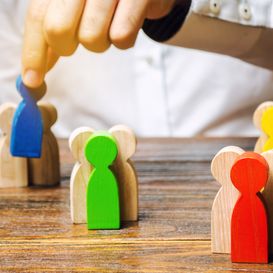
2. Positioning and ECP activities
Positioning of Eureka, the ECP and ITEA and ECP activities and events
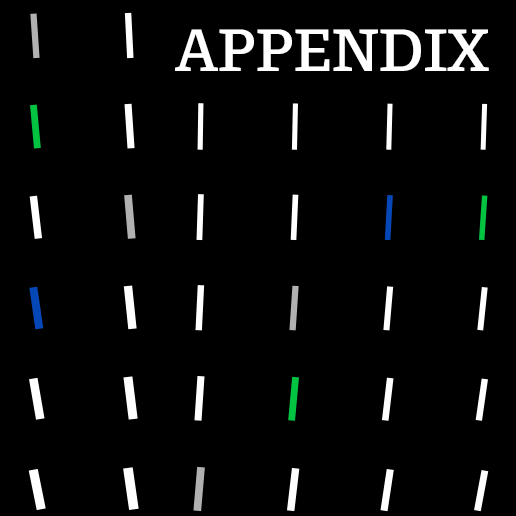
Appendix A. Call statistics per year and per country
Participation in person-years per Call and per country per year


